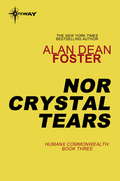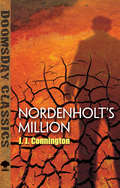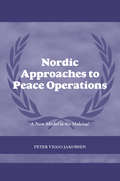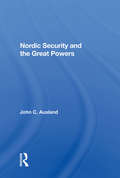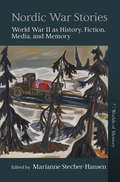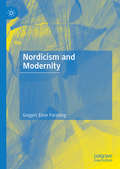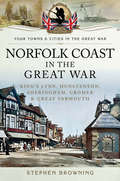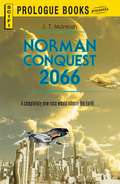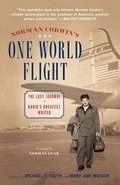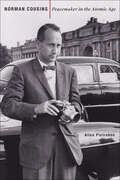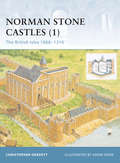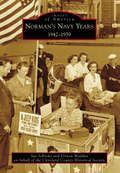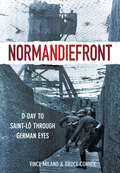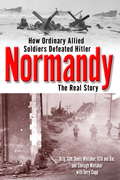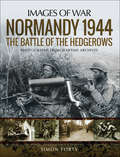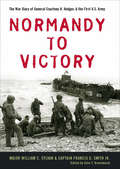- Table View
- List View
Nonviolence: The History of a Dangerous Idea
by Mark KurlanskyIn this timely, highly original, and controversial narrative, New York Times bestselling author Mark Kurlansky discusses nonviolence as a distinct entity, a course of action, rather than a mere state of mind. Nonviolence can and should be a technique for overcoming social injustice and ending wars, he asserts, which is why it is the preferred method of those who speak truth to power. Nonviolence is a sweeping yet concise history that moves from ancient Hindu times to present-day conflicts raging in the Middle East and elsewhere. Kurlansky also brings into focus just why nonviolence is a "dangerous" idea, and asks such provocative questions as: Is there such a thing as a "just war"? Could nonviolence have worked against even the most evil regimes in history?Kurlansky draws from history twenty-five provocative lessons on the subject that we can use to effect change today. He shows how, time and again, violence is used to suppress nonviolence and its practitioners-Gandhi and Martin Luther King, for example; that the stated deterrence value of standing national armies and huge weapons arsenals is, at best, negligible; and, encouragingly, that much of the hard work necessary to begin a movement to end war is already complete. It simply needs to be embraced and accelerated.Engaging, scholarly, and brilliantly reasoned, Nonviolence is a work that compels readers to look at history in an entirely new way. This is not just a manifesto for our times but a trailblazing book whose time has come.From the Hardcover edition.
Noonday: A Novel (Life Class Trilogy #3)
by Pat BarkerA new novel from the Booker Prize winning Pat Barker, author of the Regeneration Trilogy, that unforgettably portrays London during the Blitz (her first portrayal of World War II) and reconfirms her place in the very top rank of British novelists.London, the Blitz, Autumn 1940. As the bombs fall on the blacked-out city, ambulance driver Elinor Brooke races from bomb sites to hospitals trying to save the lives of injured survivors, working alongside former friend Kit Neville, while her husband Paul Tarrant works as an air-raide warden. Once fellow students at the Slade School of Fine Art before the First World War destroyed the hopes of their generation, they now find themselves caught in another war, this time at home. As the bombing intensifies, the constant risk of death makes all three reach out for quick consolation. And into their midst comes the spirit medium Bertha Mason, grotesque and unforgettable, whose ability to make contact with the deceased finds vastly increased demands as death rains down from the skies. Old loves and obsessions resurface until Elinor is brought face to face with an almost impossible choice. Completing the story of Elinor Brooke, Paul Tarrant and Kit Neville begun with Life Class and continued with Toby's Room, Noonday is both a stand-alone novel and the climax of a trilogy. Writing about the Second World War for the first time, Pat Barker brings the besieged and haunted city of London into electrifying life in her most powerful novel since the Regeneration trilogy.
Nor Crystal Tears
by Alan Dean FosterIn the beginning, before Man and the insect Thranx became allies, in the days when the reptilian AAnn were just occasional raiders of the Thranx colony worlds, one young Thranx agricultural expert lived a life of quiet desperation. A dreamer in a world of sensible well adjusted socialised beings, Ryo buried himself in his work of reclaiming marshland until... Until he met the Aliens. Grotesque two legged creatures, unpleasingly soft skinned, gross in their appetites, alarming in their movements, all in all pretty revolting species, yet his curiosity overcame his queasiness and he befriended them. And discovered they were called Man.
Nordenholt's Million (Dover Doomsday Classics)
by J. J. ConningtonFamine sweeps across the world when a lab accident unleashes a virulent strain of bacteria that transforms healthy fields into barren wastelands. With the fate of the human race at stake, wealthy financier Stanley Nordenholt establishes a stronghold in central Scotland and assumes dictatorial powers to save what remains of the planet's starving population. This gripping tale of survival explores some of the moral dilemmas that arise in the wake of catastrophic events as well as their social, cultural, and political consequences. A precursor to the latter-day tales from the golden age of science fiction, this compelling novel was published by a noted British chemist in 1923. Acclaimed by the Encyclopedia of Science Fiction as "realistic, reasoned, sociologically observed, and credible," it offers an ever-relevant warning against the exploitation of disaster as a pretext for the suspension of freedom, democracy, and justice.
Nordic Approaches to Peace Operations: A New Model in the Making (Cass Series On Peacekeeping Ser. #Vol. 22)
by Peter Viggo JakobsenA new examination of Nordic approaches to peace operations after the Cold War. It shows how the Nordic countries (Denmark, Finland, Norway and Sweden) remain relevant for the study and practice of post-Cold War peace operations.This unique study is structured around eleven success conditions derived from an analysis of the lessons learned
Nordic Security And The Great Powers
by John C. AuslandThis book contains a remarkable amount of information about Soviet intelligence activities. It includes a partial list of Soviet agents which the Nordic countries expelled after 1970 and discusses the security policies of these countries.
Nordic War Stories: World War II as History, Fiction, Media, and Memory (Worlds of Memory #7)
by Marianne Stecher-HansenSituated on Europe’s northern periphery, Denmark, Finland, Iceland, Norway, and Sweden found themselves caught between warring powers during World War II. Ultimately, these nations survived the conflict as sovereign states whose wartime experiences have profoundly shaped their historiography, literature, cinema and memory cultures. Nordic War Stories explores the commonalities and divergences among the five Nordic countries, examining national historiographies alongside representations of the war years in canonical literary works, travel writing, and film media. Together, they comprise a valuable companion that challenges the myth of Scandinavian homogeneity while demonstrating the powerful influence that the war continues to exert on national identities.
Nordic War Stories: World War II as History, Fiction, Media, and Memory (Worlds of Memory #7)
by Marianne Stecher-HansenSituated on Europe’s northern periphery, Denmark, Finland, Iceland, Norway, and Sweden found themselves caught between warring powers during World War II. Ultimately, these nations survived the conflict as sovereign states whose wartime experiences have profoundly shaped their historiography, literature, cinema and memory cultures. Nordic War Stories explores the commonalities and divergences among the five Nordic countries, examining national historiographies alongside representations of the war years in canonical literary works, travel writing, and film media. Together, they comprise a valuable companion that challenges the myth of Scandinavian homogeneity while demonstrating the powerful influence that the war continues to exert on national identities.
Nordicism and Modernity
by Gregers Einer ForsslingThis book offers a complete narrative of the development of Nordicism, from its roots in the National Romantic movement of the late eighteenth century, through to its most notorious manifestation in Nazi Germany, and finally to the fragmented forms that still remain in contemporary society. It is distinctive in treating Nordicism as a phenomenon with its own narrative, rather than as discreet episodes in works studying aspects of Eugenics, Nationalism, Nazism and the reception history of Old Norse culture. It is also distinctive in applying to this narrative a framework of analysis derived from the parallel theories of Roger Griffin and Zygmunt Bauman, to examine Nordicism as a process of myth creation protecting both the individual and society from the challenges and terror of an ever-changing and accelerating state of modernity.
Norfolk Coast in the Great War: King's Lynn, Hunstanton, Sheringham, Cromer and Great Yarmouth (Your Towns & Cities in the Great War)
by Stephen BrowningNorfolk Coast in the Great War focuses on the trials and joys, the achievements and disappointments, the humor and the sadness of everyday life in a region living on the edge of the country at the heart of the Kings vast Empire. Everyone from the folk who went off to fight, to scouts and schoolchildren, had a role to play in this coastline that had, since the time of the Spanish Armada, been considered a likely place for an enemy invasion. There were days of great tension, even terror, such as on the day of the first bombardment of the coast by the German Navy, and the day of Zeppelin attacks and dog fights out to sea when the flimsy planes of a fledgling RAF took on the Red Baron and his comrades.This unique study is based largely on original archive material, much of it never before published in book form. It is accompanied by many rare and fascinating photographs that show the day-to-day life of the people who lived in the many settlements on the coast and just inland. In addition, this book also gives an itinerary for a walk along the 46 mile stretch of the coast from Hunstanton to Cromer, taking in many of the places discussed and giving views that are exactly the same as they were 100 years ago.
Norfolk at War, 1939–45 (Your Towns And Cities In World War Two Ser.)
by Stephen BrowningThis year-on-year study of Norfolk at war is the first such for many years, which utilizes material that has not been published in book form before or, sometimes, at all. In both the First and Second World War, Norfolk was pivotal, albeit for different reasons. During the war of 1939-45 Norfolk was home to many bases of the USAAF, changing the area forever with bases remaining a fond feature of Norfolk life. Another unique and enduring legacy was the arrival and often permanent settlement of many Poles, who are commemorated today by a shrine in the Cathedral of St John the Baptist in Norwich. Norfolk was in many ways changed forever as it had largely, up until this time, been proudly, even stubbornly, isolated a feature that could not have changed more dramatically. This study is both inevitably a military and social study. The major events both at home and overseas are laid out, together with a description of how home life unfolded in very dark times when the stoicism and humor of the Norfolk residents were tested. Contemporary material from newspapers, diaries and local records, as well as over 200 photographs, are used to bring life and color and life to the account.
Norman Conquest 2066
by J. T. McintoshA new race would inherit the Earth.Tormented by neuroses, psychoses, and instability, mankind changed, and two new breeds of humans were born:Normans - devoid of body hair, quiet, rational, hiding a strange new power. And Sexons - wild, animalistic, with lustful urges.And each one was convinced it was Earth’s true heir.
Norman Corwin's One World Flight: The Lost Journal of Radio's Greatest Writer
by Norman Corwin Michael C. Keith Mary Ann WatsonA towering figure in broadcast history, Norman Corwin has long been known as "Radio's Poet Laureate." In the late 1930s, a creative revolution was underway in the medium. What some people still called "the wireless" was maturing from a novelty into an art form. After a ten-year career as a newspaperman, columnist, and critic--which began at the age of 17--Corwin joined the ranks of aural provocateurs such as Archibald MacLeish, Arch Oboler, and Orson Welles.
Norman Cousins: Peacemaker in the Atomic Age (Johns Hopkins Nuclear History and Contemporary Affairs)
by Allen PietrobonAs the editor of the Saturday Review for more than thirty years, Norman Cousins had a powerful platform from which to help shape American public debate during the height of the Cold War. Under Cousins's leadership, the magazine was considered one of the most influential in the literary world. Cousins's progressive, nonpartisan editorials in the Review earned him the respect of the public and US government officials. But his deep impact on postwar international humanitarian aid, anti-nuclear advocacy, and Cold War diplomacy has been largely unexplored. In this book, Allen Pietrobon presents the first true biography of Norman Cousins. Cousins was much more important than we realize: he was involved in several secret citizen diplomacy missions during the height of the Cold War and, acting as a private citizen, played a major role in getting the Limited Test Ban Treaty signed. He also wrote JFK's famous 1963 American University commencement speech ("not merely peace in our time but peace for all time"). This book is a fascinating look at the outsized impact that one individual had on the course of American public debate, international humanitarianism, and the Cold War itself. This biography of the vocal anti-communist and anti-nuclear activist's public life will interest readers across the ideological spectrum.
Norman Mailer: The Naked and the Dead & Selected Letters 1945-1946 (LOA #364)
by Norman MailerA landmark in the modern literature of war by a still-controversial literary iconIncludes a selection of letters—nine never before published—that reveal the real life roots of one of the greatest American debut novels of the last centuryNearly universally praised upon publication as an achievement inviting comparison with Tolstoy and Hemingway, Norman Mailer's The Naked and the Dead is not just a monumental war novel but also a devastating antiwar novel, exposing the primal nature of power through the interplay of a platoon of soldiers on an impossible and ultimately pointless mission on an obscure island in the Pacific during World War II. Written just after the war ended, in the early days of the emerging Cold War, the novel daringly engages with the authoritarian impulses in the American character.To celebrate and commemorate the centennial of Mailer&’s birth and the 75th anniversary of the publication of his unforgettable debut novel, this expanded collector&’s edition includes a selection of 23 letters (all but four from Mailer to his first wife, Beatrice) chosen by Mailer biographer J. Michael Lennon that reveals the keen insight and powerful ambition of a brilliant young writer grappling with the challenge of converting the weight of experience into art.
Norman Stone Castles
by Adam Hook Christopher GravettDescended from the Viking raiders who settled in Northern France under the leadership of Rollo in around 911, the Normans were amongst the most feared warriors of their time. Their territorial ambitions culminated in Duke William 1's conquest of England in 1066, but although victory at Hastings left the English crown in William's hands, Norman sovereignty remained far from established on the island. In order to consolidate his position, the new king built a series of fortifications across the country - this book covers all these developments from the early days of William I through to the fortifications of Henry II, Richard I and John.
Norman's Navy Years: 1942-1959 (Images of America)
by Cleveland County Historical Society Sue Schrems Vernon MadduxIn 1944, A.L. Simon, a sailor at the Norman Naval Air Station, illustrated a booklet, "On the Beach," about Navy life in Norman, Oklahoma. The title he chose reflected the irony of the US Navy establishing two bases in a landlocked prairie town in 1942. The initial activation of the Navy bases (from 1942 to 1945) and their reactivation (from 1952 to 1959) greatly increased the employment rate and economy in Norman, offering locals a much-needed boost after the Great Depression of the 1930s. The men who influenced the Navy to choose Norman as the location for Navy installations were T. Jack Foster, of the Norman Chamber of Commerce; Joseph Brandt, president of the University of Oklahoma; and Savoie Lottinville, director of the University of Oklahoma Press.
Normandie Triangle
by Justin ScottWorld War II has just broken out. A brilliant Nazi saboteur-- code name: the Otter, son of Abwehr director Wilhelm Canaris-- prowls America. His first masterstroke: capsizing by arson in New York harbor the 1,000-foot Normandie, the super-liner-turned-troopship that could have outrun Germany's U-boats. Naval architect Steven Gates determines to raise the Normandie, put her back into the war. The Otter determines to raise the stakes: sink the Queen Mary, 12,000 troops aboard. Method: a sequestered mini-U-boat. Result: the blocking of New York harbor to Allied ships for the duration. The odds: a thousand to one-- exactly to the Otter's liking. Gates probes the treacherous, upended labyrinth of Normandie's sunken hull, marveling at her ingenious construction, and suddenly discerning the Otter's design for disaster, not only for the Allies' war effort but for himself, as he touches off a manhunt that nearly costs him the love of the only woman who can save him.
Normandiefront: D-Day to Saint-Lo Through German Eyes
by Vince Milano Bruce ConnerIn the cold morning of June 6, 1944, thousands of German soldiers are in position from Port en Bessin eastwards past Colleville on the Normandy coast, aware that a massive invasion force is heading straight for them. According to Allied Intelligence, they shouldn’t be there. 352 infantry division would ensure the invaders would pay a massive price to take Omaha beach. There were veterans from the Russian front amongst them and they were well trained and equipped. The presence of 352 Division meant that the number of defenders was literally double the number expected – and on the best fortified of all the invasion beaches. What makes this account of the bloody struggle unique is that it is told from the German standpoint, using firsthand testimony of German combatants. There are not many of them left and these accounts have been painstakingly collected by the authors over many years.
Normandy
by Shelagh Whitaker Dennis Whitaker"It was the [allied armies'] valor, their endurance, and their ability to adapt that won the battle of Normandy and launched the liberation of Western Europe." --from Normandy: The Real StoryFor decades, it's been the conventional wisdom that "brute force" alone beat the German army at Normandy. Now a definitive new history, coauthored by a highly decorated field commander, proves otherwise. Using archival data, oral histories, and exclusive new interviews, Normandy: The Real Story takes the reader deep into the minds, hearts, and souls of the allied armies to show how--despite the shortcomings of their superiors and the inferiority of their weaponry--they destroyed two well-equipped German armies and won the war.Here is the crucial summer of 1944 as seen by both sides, from the British spy, code-named "Garbo," who successfully misled the Nazis about the time and place of the D-day landings, to the poor planning for action after the assault that forced the allies to fight for nine weeks "field to field, hedgerow to hedgerow." Here too are the questionable command decisions of Montgomery, Eisenhower, and Bradley, the insatiable ego of Patton. Yet, fighting in some of the most miserable conditions of the war, the allied soldiers used ingenuity, resilience, and raw courage to drive the enemy from France in what John Keegan describes as "the biggest disaster to hit the German army in the course of the war." Normandy is an inspiring tribute to the common fighting men of five nations who won the pivotal campaign that lead to peace and freedom.From the Trade Paperback edition.
Normandy '44: D-Day and the Epic 77-Day Battle for France
by James HollandA history of World War II’s Operation Overlord, from the campaign’s planning to its execution, as Allied forces battled to take France back from Germany.D-Day, June 6, 1944, and the seventy-six days of bitter fighting in Normandy that followed the Allied landing, have become the defining episode of World War II in the west—the object of books, films, television series, and documentaries. Yet as familiar as it is, as James Holland makes clear in his definitive history, many parts of the Overlord campaign, as it was known, are still shrouded in myth and assumed knowledge.Drawing freshly on widespread archives and on the testimonies of eye-witnesses, Holland relates the extraordinary planning that made Allied victory in France possible; indeed, the story of how hundreds of thousands of men, and mountains of materiel, were transported across the English Channel, is as dramatic a human achievement as any battlefield exploit. The brutal landings on the five beaches and subsequent battles across the plains and through the lanes and hedgerows of Normandy—a campaign that, in terms of daily casualties, was worse than any in World War I—come vividly to life in conferences where the strategic decisions of Eisenhower, Rommel, Montgomery, and other commanders were made, and through the memories of paratrooper Lieutenant Dick Winters of Easy Company, British corporal and tanker Reg Spittles, Thunderbolt pilot Archie Maltbie, German ordnance officer Hans Heinze, French resistance leader Robert Leblanc, and many others.For both sides, the challenges were enormous. The Allies confronted a disciplined German army stretched to its limit, which nonetheless caused tactics to be adjusted on the fly. Ultimately ingenuity, determination, and immense materiel strength—delivered with operational brilliance—made the difference. A stirring narrative by a pre-eminent historian, Normandy ‘44 offers important new perspective on one of history’s most dramatic military engagements and is an invaluable addition to the literature of war.Praise for Normandy ‘44An Amazon Best Book of the Month (History)An Amazon Best History Book of the Year“Detail and scope are the twin strengths of Normandy ’44. . . . Mr. Holland effectively balances human drama with the science of war as the Allies knew it.” —Jonathan W. Jordan, Wall Street Journal“A superb account of the invasions that deserves immense praise. . . . To convey the human drama of Normandy requires great knowledge and sensitivity. Holland has both in spades.” —Times (UK)
Normandy 1944: Photographs From Wartime Archives (Images of War)
by Simon FortyCaen, a D-Day objective on 6 June 1944, did not fall to the British and Canadian troops of Second Army until 6 August, by which time much of the city had been reduced to rubble. The two-month struggle was a crucial stage in the Normandy campaign and, as Simon Forty demonstrates in this photographic history, one of the most controversial.His detailed, graphic account gives the reader a fascinating insight into the opposing forces, the conditions, the terrain, the equipment and weaponry deployed and it illustrates just how intense and protracted the fighting was on the ground.The reasons for the slow Allied advance have been hotly disputed. Deficiencies in British and Canadian equipment and tactics have been blamed, as has the tenacity of the German resistance. Ultimately a sequence of Allied operations sapped the defenders strength, and it is these operations Perch, Martlet, Epsom, Windsor, Charnwood, Jupiter, Atlantic, Goodwood that feature strongly in the striking photographs that have been selected for this book.They record in the most dramatic fashion the character of the fighting and show how even the SS divisions and heavy tank battalions were eventually defeated.
Normandy 1944: The Battle Of The Hedgerows (Images Of War Ser.)
by Simon FortyJust as the Anglo-Canadian forces in the east found it difficult to advance beyond Caen after D-Day, so the US First Army laboured to advance through the Norman bocage country in the west. The lethal struggle that developed there was a defining episode in the Normandy campaign, and this photographic history is a vivid introduction to it.Through a selection of over 150 carefully chosen and meticulously captioned wartime photographs Simon Forty traces the course of the battle and gives the reader a graphic impression of the conditions, the terrain and the experience of the troops.The Germans mounted a tenacious defence. They fought from prepared positions in the high hedgerows. Each cramped field and narrow lane became a killing ground. But the Americans adapted their tactics and brought in special equipment including bulldozers and tanks with hedgerow cutters to force their way through.The losses were appalling as the Germans used snipers, mines, machineguns and artillery to great effect. Inexorably, however, and with enormous bravery, First Army solved their tactical problems, inflicted heavy casualties on the defenders and ground their way to Saint-L.
Normandy Crucible: The Decisive Battle that Shaped World War II in Europe
by John Prados<p>The Battle of Normandy began on D-Day. June 6, 1944—the day that the Allied forces launched the great crusade to free Europe from the iron grip of Nazi Germany. Tightly constricted hedgerow country and bitter German resistance held the Allied advance to a crawl—until they broke through and trapped the Nazi armies. Yet within weeks of this stunning disaster, the Germans smashed the most dangerous Allied offensive yet. <p>How was this possible? Noted author John Prados answers this vexing question with an account that reframes the Normandy breakout. Shifting between battle action and command decisions on both sides, <i>Normandy Crucible</i> lucidly illustrates how this campaign molded the climactic battle for Europe.</p>
Normandy to Victory: The War Diary of General Courtney H. Hodges & the First U.S. Army (American Warriors Series #Amws)
by Major William C. Sylvan Captain Francis G. Smith Jr.This annotated edition of General Hodges&’s WWII diary offers a unique firsthand account of the First US Army from D-Day to V-E Day: &“a fascinating book&” (Bowling Green Daily News). During World War II, General Courtney Hicks Hodges commanded the First US Army, taking part in the Allied invasion of France, the liberation of Paris, and the ultimate Allied victory in 1945. Maintained by two of Hodges's aides, Major William C. Sylvan and Captain Francis G. Smith Jr., this military journal offers a unique firsthand account of the actions, decisions, and daily activities of General Hodges and the First Army throughout the war. The diary opens on June 2, 1944, as Hodges and the First Army prepare for the Allied invasion of France. In the weeks and months that follow, the diary highlights the crucial role that Hodges's command played in the Allied operations in northwest Europe. The diary recounts the First Army's involvement in the fight for France, the Siegfried Line campaign, the Battle of the Bulge, the drive to the Roer River, and the crossing of the Rhine, following Hodges and his men through savage European combat until the German surrender in May 1945. This historically significant text has previously been available only to military historians and researchers. Retired US Army historian John T. Greenwood has now edited the text in its entirety and added a biography of General Hodges as well as extensive contextual notes. A Choice Outstanding Academic TitleWinner of the 2009 Distinguished Writing Award from the Army Historical Foundation


